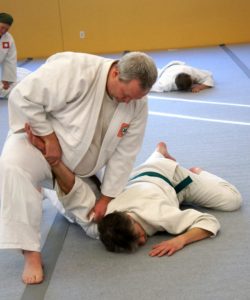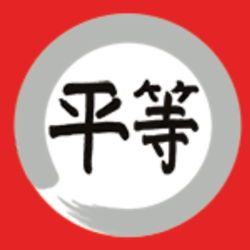Clothing
 Many Aikido movements involve kneeling or sliding on the mat. As such, we recommend wearing clothes that cover knees and elbows and do not restrict movement. Sweat pants or yoga pants and long-sleeve knit shirts are excellent choices for training. Jeans or pants with lots of buttons or zippers are not recommended. We also ask that you not wear clothing that could stain or damage the mat.
Many Aikido movements involve kneeling or sliding on the mat. As such, we recommend wearing clothes that cover knees and elbows and do not restrict movement. Sweat pants or yoga pants and long-sleeve knit shirts are excellent choices for training. Jeans or pants with lots of buttons or zippers are not recommended. We also ask that you not wear clothing that could stain or damage the mat.
Socks are not needed, as we train barefoot. You may wear socks if removing them would make you uncomfortable, but be aware that the canvas mat may be slippery.
Though not required for beginners, a martial arts uniform (called a dogi) may also be worn. We use judo uniforms that have thicker padding, although any white or off-white uniform with a white belt may be worn. If you continue with Aikido training, you will eventually want to acquire a uniform. Dogi are available for purchase at local martial arts supply stores or online – talk to an instructor if you are interested.
Please remove watches and jewelry, and make sure any pockets are empty before class. If you wear glasses, you may find a sports band helpful.
You are welcome to change into training clothes at the Waterbury building. While we do not have changing rooms in the dojo, there are nearby restrooms in the building with plenty of room for changing.
Safety
 The most important aspect of Aikido training is safety. The techniques are designed to be as safe as possible, but classes can be physically demanding. Ultimately, you are the best judge of your physical state. We encourage you to push your limits in our classes, but if you feel ill or otherwise unable to continue, please feel free to sit out until you feel ready to rejoin the class. (Please alert the instructor if you need to sit out so they know whether you require assistance.) If you have an injury that makes certain movements painful or impossible, please let the instructor and your partner know so you can avoid injury. Likewise, pay attention to your partner and loosen pressure if they indicate that a grip or control has become painful.
The most important aspect of Aikido training is safety. The techniques are designed to be as safe as possible, but classes can be physically demanding. Ultimately, you are the best judge of your physical state. We encourage you to push your limits in our classes, but if you feel ill or otherwise unable to continue, please feel free to sit out until you feel ready to rejoin the class. (Please alert the instructor if you need to sit out so they know whether you require assistance.) If you have an injury that makes certain movements painful or impossible, please let the instructor and your partner know so you can avoid injury. Likewise, pay attention to your partner and loosen pressure if they indicate that a grip or control has become painful.
The mat can become crowded during class so all students must pay attention to their surroundings. Only perform throws or pins if you are sure that your partner can land safely. If there is an obstruction, either end the technique or adjust your position so that the technique can proceed safely. When practicing breakfalls, make sure that you will not run into others or end up falling off the mat. By remaining aware of our surroundings, of our partners, and our own bodies, we can continue to enjoy injury-free Aikido training.
COVID-19 and Other Communicable Diseases Policy
Our study of Aikido involves close physical contact, and so we take precautions to prevent the spread of illnesses to our training partners and our broader community. An important concept in the study of Aikido is practicing harmony with others, and that practice happens both on and off the mat. One of the ways that we can practice harmony with others is by protecting the health of ourselves and those in our community.
We ask that students follow these practices as a way of making harmony and protecting the health of our community:
- If you are sick, stay home to rest and recover
- Please stay up to date on vaccines to protect your health and the health of others
- Follow the CDC guidelines on masking: Please wear a mask for the full 10 days following a Covid-19 infection or known exposure, if you have any respiratory symptoms, or if you are at high risk of getting sick
- Students are always welcome to train with masks
We will monitor the risk levels of our local community. If risk levels for any communicable illness are high, we may implement additional measures to prevent the spread of illness.
